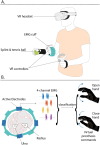Effects of game design characteristics of a virtual reality serious game for upper-limb prosthesis control training on motor learning
- PMID: 40600166
- PMCID: PMC12209274
- DOI: 10.3389/fresc.2025.1520184
Effects of game design characteristics of a virtual reality serious game for upper-limb prosthesis control training on motor learning
Abstract
Introduction: Rehabilitation outcomes of hand prosthesis control training generally benefit from an early start in the rehabilitation regimen as well as the use of modern technologies, like serious games, in lieu of more conventional methods. In this study, we tested a virtual reality based myoelectric prosthesis training serious game, specifically how the game design elements affected different aspects of motor control and training.
Methods: Ten able-bodied participants were asked to execute a series of tasks by controlling an LDA-controlled 1-DoF virtual hand prosthesis within a virtual reality environment (VRE) serious game. The tasks included grasping and manipulating virtual objects and controlled force modulation, the latter facilitated by artificial feedback communicated to participants in the VRE.
Results: The results indicated that the game physics affected the way that the participants completed the tasks, while the tasks themselves appeared to be approached and executed in different ways by the participants. Contrary to expectations, however, the force feedback did not influence the participants' ability to precisely modulate the grasping force applied with the virtual prosthesis.
Discussion: Based on these results, it can be concluded that users can be trained within the proposed framework to develop motor skills that might be translated into the use of a real prosthesis, in a more engaging and timely manner.
Keywords: EMG control; motor rehabilitation; prosthesis control; prosthesis training; serious games; virtual reality.
© 2025 Tchimino, Maas, van Dijk, Murgia, van der Sluis and Bongers.
Conflict of interest statement
The authors declare that the research was conducted in the absence of any commercial or financial relationships that could be construed as a potential conflict of interest.
Figures








Similar articles
-
Interventions for motor rehabilitation in people with transtibial amputation due to peripheral arterial disease or diabetes.Cochrane Database Syst Rev. 2023 Jun 5;6(6):CD013711. doi: 10.1002/14651858.CD013711.pub2. Cochrane Database Syst Rev. 2023. PMID: 37276273 Free PMC article.
-
Using Pupillometry in Virtual Reality as a Tool for Speech-in-Noise Research.Ear Hear. 2025 Jul 2. doi: 10.1097/AUD.0000000000001692. Online ahead of print. Ear Hear. 2025. PMID: 40600729
-
Effect of serious games over conventional therapy in the rehabilitation of people with multiple sclerosis - a systematic review and meta-analysis.Disabil Rehabil. 2025 Jun;47(13):3224-3244. doi: 10.1080/09638288.2024.2415328. Epub 2024 Oct 18. Disabil Rehabil. 2025. PMID: 39421950
-
Eliciting adverse effects data from participants in clinical trials.Cochrane Database Syst Rev. 2018 Jan 16;1(1):MR000039. doi: 10.1002/14651858.MR000039.pub2. Cochrane Database Syst Rev. 2018. PMID: 29372930 Free PMC article.
-
Applying Augmented Reality to Convey Medical Knowledge on Osteoclasts to Users of a Serious Game: Vignette Experiment.JMIR Serious Games. 2025 Jun 16;13:e64751. doi: 10.2196/64751. JMIR Serious Games. 2025. PMID: 40523213 Free PMC article.
References
-
- Bessa D, Rodrigues NF, Oliveira E, Kolbenschag J, Prahm C. Designing a serious game for myoelectric prosthesis control. 2020 IEEE 8th International Conference on Serious Games and Applications for Health (SeGAH) (2020). p. 1–5. 10.1109/SeGAH49190.2020.9201812 - DOI
LinkOut - more resources
Full Text Sources

